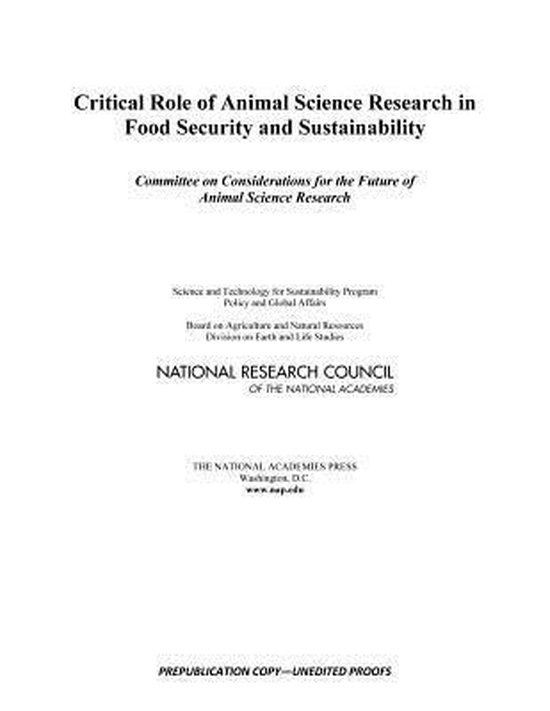By 2050 the world's population is projected to grow by one-third, reaching between 9 and 10 billion. With globalization and expected growth in global affluence, a substantial increase in per capita meat, dairy, and fish consumption is also anticipated. The demand for calories from animal products will nearly double, highlighting the critical importance of the world's animal agriculture system. Meeting the nutritional needs of this population and its demand for animal products will require a significant investment of resources as well as policy changes that are supportive of agricultural production. Ensuring sustainable agricultural growth will be essential to addressing this global challenge to food security. Critical Role of Animal Science Research in Food Security and Sustainability identifies areas of research and development, technology, and resource needs for research in the field of animal agriculture, both nationally and internationally. This report assesses the global demand for products of animal origin in 2050 within the framework of ensuring global food security; evaluates how climate change and natural resource constraints may impact the ability to meet future global demand for animal products in sustainable production systems; and identifies factors that may impact the ability of the United States to meet demand for animal products, including the need for trained human capital, product safety and quality, and effective communication and adoption of new knowledge, information, and technologies. The agricultural sector worldwide faces numerous daunting challenges that will require innovations, new technologies, and new ways of approaching agriculture if the food, feed, and fiber needs of the global population are to be met. The recommendations of Critical Role of Animal Science Research in Food Security and Sustainability will inform a new roadmap for animal science research to meet the challenges of sustainable animal production in the 21st century. Table of Contents Front Matter Summary 1 Introduction: Overview of the Challenges Facing the Animal Agriculture Enterprise 2 Global Food Security Challenge: Sustainability Considerations 3 Animal Agriculture Research Needs: U.S. Perspective 4 Global Considerations for Animal Agriculture Research 5 Capacity Building and Infrastructure for Research in Food Security and Animal Sciences 6 Recommendations Appendix A: Committee on Considerations for the Future of Animal Science Research: Biographical Information Appendix B: Statement of Task Appendix C: Glossary Appendix D: Key Strategies Involving Animal Agriculture Being Focused on by USDA Research, Education, and Economics (REE) Appendix E: USDA ARS Proposed FY 2015 Priorities Appendix F: Animal Health Priorities from a 2011 USDA NIFA Workshop Appendix G: Results of a USDA ARS- and NIFA-Sponsored Workshop on Animal Health Appendix H: Summary of NOAA/USDA Findings on Alternative Feeds for Aquaculture Appendix I: Goals for Priorities Identified by the EU Animal Task Force Appendix J: USDA NIFA Investment in Animal Science by Species (Subject of Interest) Appendix K: Animal Science Investment by Knowledge Area Appendix L: USDA ARS Animal/Agriculture Research FY 2010FY 2014
